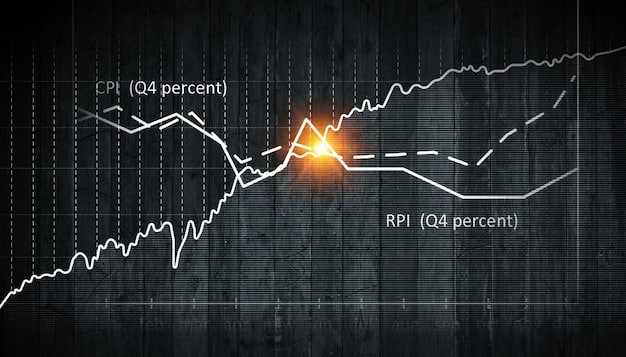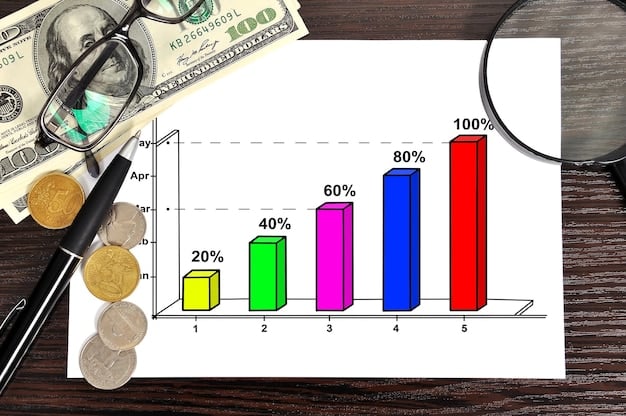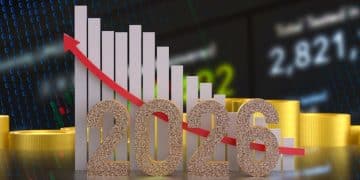New Corporate Tax Rate 2025: Impact on US Business Investments?

The potential impact of a new corporate tax rate on US business investments in 2025 is a complex issue, with economists divided on whether increased taxation will stifle growth or merely reallocate capital, necessitating a nuanced understanding of its various implications.
The landscape of corporate taxation in the United States is perennially under scrutiny, significantly influencing decision-making across boardrooms nationwide. As we approach 2025, a critical question emerges: Is the New Corporate Tax Rate Impacting US Business Investments in 2025? This inquiry delves into the intricate relationship between fiscal policy and economic growth, scrutinizing how prospective tax changes could reshape the nation’s investment climate.
Understanding the Proposed Corporate Tax Rate Changes
The discussion surrounding new corporate tax rates for 2025 is rich with proposals and contentious debates. While specifics may vary, the general thrust often involves a potential increase from the rates established by the Tax Cuts and Jobs Act (TCJA) of 2017. These proposed changes are not isolated, but rather part of broader fiscal strategies aimed at addressing national debt, funding social programs, or realigning economic incentives.
Historically, corporate tax rates have been a lever for various administrations to stimulate or stabilize the economy. The reduction under the TCJA was intended to boost domestic investment and competitiveness, with mixed results according to different analyses. Now, the conversation shifts to whether a reversal, or at least a significant adjustment, is imminent and what immediate and long-term effects such a shift would entail.
The Historical Context of US Corporate Taxation
To fully grasp the magnitude of potential changes, it’s essential to look back at the historical trajectory of US corporate taxation. Over decades, the corporate tax rate has fluctuated considerably, often responding to economic pressures and political ideologies. From peak rates in the mid-20th century to the significant cut in 2017, each adjustment has left an indelible mark on how businesses operate and strategize.
- Pre-TCJA Era: Prior to 2017, the US statutory corporate tax rate stood at 35%, one of the highest among developed nations, though effective rates were often lower due to various deductions and credits.
- TCJA of 2017: This landmark legislation slashed the corporate tax rate to 21%, a move championed as a catalyst for economic expansion and a measure to repatriate foreign earnings.
- Current Discussions: The present debate often centers on raising the rate to somewhere between 25% and 28%, with proponents arguing for increased public revenue and critics fearing a drag on economic activity.
These historical precedents provide valuable context, illustrating that adjustments to corporate tax rates are never made in a vacuum. They are deeply intertwined with overarching economic philosophies and intended outcomes, making the 2025 outlook a continuation of this dynamic policy evolution.

Economic Theories and Investment Behavior
The academic and policy discussions around corporate tax rates are often grounded in various economic theories that attempt to predict business investment responses. Two prominent schools of thought often clash: supply-side economics and Keynesian theory. Supply-siders typically argue that lower corporate taxes encourage businesses to invest more, innovate, and create jobs, as they retain a larger share of their profits. Conversely, Keynesian economists might contend that while lower taxes could leave more capital in corporate hands, actual investment is more heavily influenced by aggregate demand and consumer spending.
It’s not just about the absolute rate, but also the perception of stability and fairness. Businesses make long-term investment decisions based on a predictable regulatory and tax environment. Uncertainty surrounding future tax policies can itself be a deterrent, causing companies to delay expansion plans or shift capital to more stable jurisdictions. Therefore, the manner in which any new corporate tax rate is introduced—and the political consensus behind it—could be as impactful as the rate itself.
Capital Allocation and Investment Decisions
When considering new investments, businesses rigorously evaluate their capital allocation strategies. This involves weighing the potential returns against the costs, including the tax burden on profits. A higher corporate tax rate effectively reduces the after-tax return on investment, which can make certain projects less attractive. For example, a company contemplating a new factory might reassess the financial viability if a larger portion of its future profits will be diverted to taxes.
Furthermore, businesses often have choices regarding where to invest. This can be domestically or internationally. If the US corporate tax rate becomes significantly higher than that of other developed nations, there’s a risk of capital flight, where companies choose to invest abroad to maximize their after-tax returns. This is a primary concern for those who advocate for maintaining competitive tax rates. However, proponents of higher rates often argue that domestic market stability, infrastructure, and skilled labor pools can offset some of the tax differential, keeping investment within US borders, particularly if the tax revenue is reinvested in these areas.
Potential Impacts on Different Business Sectors
The effects of a new corporate tax rate are unlikely to be uniform across all sectors of the US economy. Different industries have varying capital expenditure requirements, profit margins, and reliance on international markets, making them more or less susceptible to changes in tax policy. For instance, capital-intensive industries such as manufacturing, energy, and infrastructure development might feel a more direct impact, as their investment cycles are longer and require substantial upfront capital.
Technology companies, often characterized by higher profit margins and significant investments in research and development (R&D), could also see shifts. While R&D tax credits might mitigate some of the impact, a higher headline rate could influence decisions on where to locate new innovation hubs or manufacturing facilities. Service-based industries, particularly those with lower capital requirements and a strong domestic focus, might be less affected in terms of direct investment but could face indirect impacts through changes in overall economic demand or consumer spending patterns.
Small Businesses vs. Large Corporations
The distinction between small and large businesses is also crucial when analyzing the impact of corporate tax changes. Large multinational corporations often have sophisticated tax planning departments and the ability to leverage international tax structures to minimize their liabilities. While a higher domestic rate would certainly affect them, their global footprint provides more flexibility.
- Small Businesses: Many small businesses are structured as pass-through entities (e.g., S corporations, LLCs, partnerships), meaning their profits are taxed at the individual income tax rate of their owners, not the corporate rate. However, some larger small businesses are structured as C-corps and would be directly impacted.
- Large Corporations: These entities typically face the full brunt of corporate tax rate changes. Their investment decisions, including mergers and acquisitions, capital expenditures, and R&D spending, are heavily scrutinized through a tax lens.
- Investment Implications: For small businesses, increased individual income taxes (if related to broader tax reforms) could curb owner investment. For large corporations, higher corporate taxes could lead them to re-evaluate domestic expansion versus international opportunities.
The ripple effect extends to how businesses of all sizes approach hiring, wage increases, and dividend payouts, all of which are interwoven with their profitability and investment capacity under a new tax regime.
The Role of International Tax Competitiveness
In an increasingly globalized economy, the corporate tax rate of a single nation does not exist in isolation. It is always benchmarked against the rates in other countries, particularly those with which the US competes for foreign direct investment (FDI). If the US rate becomes significantly higher than the global average, it could deter foreign companies from investing in the US and encourage American companies to move operations or profits offshore.
The TCJA, with its sharp reduction to 21%, was partly designed to bring the US rate more in line with the OECD average, thereby enhancing its international competitiveness. Any proposals for a new corporate tax rate in 2025 must directly confront this issue. Policy makers must weigh the need for domestic revenue against the risk of losing capital and jobs to countries with more favorable tax environments. This delicate balancing act forms a cornerstone of the ongoing debate.
Global Trends in Corporate Taxation
Corporate tax policies worldwide are constantly evolving. Many countries have lowered their rates in recent decades to attract investment, creating a global “race to the bottom” to some extent. However, there’s also a growing international movement, spearheaded by organizations like the OECD, to establish a global minimum corporate tax rate. This initiative aims to curb tax avoidance by multinational corporations and ensure that they pay a fair share wherever they operate.
Should a global minimum tax come into widespread effect, it could significantly alter the dynamics of international tax competitiveness. If a new US corporate tax rate aligns with or surpasses this global minimum, it might mitigate some of the concerns about capital flight, as the incentive to move profits to ultra-low-tax jurisdictions would diminish. However, the implementation and enforcement of such a global agreement remain complex and subject to ongoing negotiations among nations.
Policy Alternatives and Mitigating Strategies
Even if a new corporate tax rate is implemented, there are various policy tools and strategies that could be employed to mitigate potential negative impacts on business investment. These often involve targeted incentives, credits, and deductions that can offset the higher headline rate for specific activities deemed beneficial to the economy, such as R&D, green energy investments, or job creation in disadvantaged areas.
One common approach is to couple a higher corporate tax rate with enhanced depreciation allowances or investment tax credits. These measures effectively reduce the cost of capital for businesses, encouraging them to invest in new equipment, technology, and facilities. Such an approach seeks to balance the need for increased tax revenue with the economic imperative of fostering growth and innovation.
Targeted Tax Incentives
Beyond broad tax credits, governments can design highly specific incentives to steer investment towards particular sectors or activities. These can include:
- Research and Development (R&D) Credits: Encouraging innovation and technological advancement by reducing the cost of R&D activities.
- Manufacturing Tax Credits: Aimed at boosting domestic production and job creation in the manufacturing sector.
- Green Investment Incentives: Tax breaks for companies investing in renewable energy, energy efficiency, and other environmentally friendly technologies.
- Opportunity Zones: Encouraging investment in economically distressed communities through tax benefits on capital gains.
The effectiveness of these incentives, however, is often debated. Critics argue that they can lead to market distortions, create complex loopholes, and disproportionately benefit larger corporations that have the resources to navigate intricate tax codes. Proponents contend that they are necessary tools to achieve specific economic and social objectives that might not be met by a broad tax rate alone.
The Political and Economic Landscape of 2025
The eventual corporate tax rate for 2025 will not be determined in a vacuum. It will emerge from a complex interplay of political priorities, economic realities, and public sentiment. The political landscape, particularly the composition of Congress and the presidential administration, will be a major determinant. Different political parties often hold divergent views on the appropriate level of corporate taxation and its role in the economy. Election outcomes in 2024 will therefore cast a long shadow over tax policy discussions for 2025 and beyond.
Economically, the state of inflation, unemployment, and GDP growth will also play a significant role. If the economy is struggling, policymakers might be more hesitant to implement tax increases that could further dampen growth. Conversely, if the economy is robust, there might be greater appetite for raising revenue to address other fiscal objectives. Public opinion, shaped by concerns about wealth inequality, corporate accountability, and the need for public services, also exerts considerable pressure on lawmakers to consider how corporations contribute to the national purse.
Stakeholder Perspectives and Advocacy
Various stakeholders will actively engage in lobbying and advocacy efforts as the 2025 tax rate approaches. Business associations, industry groups, labor unions, and non-profit organizations will all present their cases to policymakers, emphasizing the potential impacts on their constituents. Businesses, naturally, will generally advocate for lower tax rates and a stable tax environment to foster investment and competitiveness.
Labor unions and social justice groups, on the other hand, might argue for higher corporate taxes to fund social programs, reduce income inequality, and ensure that corporations pay their “fair share” towards societal welfare. These competing interests will make the legislative process dynamic and challenging, with the final outcome likely reflecting a compromise among diverse viewpoints. Understanding these different perspectives is crucial for anticipating the ultimate shape of US corporate tax policy in 2025.

Forecasting Investment Trends Under New Tax Regimes
Forecasting the precise impact of a new corporate tax rate on US business investments is inherently challenging, as many variables interact. However, economic models and historical data offer some insights. Generally, a higher corporate tax rate is expected to lead to a decrease in domestic investment, all else being equal, due to reduced after-tax returns. This can manifest in fewer new projects, slower expansion, and potentially a redirection of capital to lower-tax jurisdictions.
Conversely, proponents of higher rates argue that if the additional revenue is wisely invested in public goods—infrastructure, education, research—it could indirectly boost private sector productivity and create a more attractive environment for long-term investment. For example, improved transportation networks or a more skilled workforce could offset some of the direct tax burden, leading to a net positive for certain types of businesses.
Scenario Analysis for 2025
To analyze the potential impacts, consider a few scenarios for 2025:
- Moderate Rate Increase (e.g., 25%): This scenario could see a marginal dampening of investment, particularly in capital-intensive sectors. However, if accompanied by targeted incentives (e.g., for manufacturing or clean energy), the overall impact might be somewhat offset.
- Significant Rate Increase (e.g., 28% or higher): A more substantial increase could lead to more pronounced shifts in investment patterns, potentially encouraging greater capital outflow and a slowdown in domestic expansion plans for some corporations.
- Rate Increase with Robust Public Investment: If higher corporate tax revenues are channeled into significant public investments (e.g., advanced infrastructure, R&D funding, educational reforms), the long-term benefits could potentially outweigh the short-term disincentives for certain businesses.
Ultimately, the actual impact will depend not just on the new rate, but on the entire package of fiscal policies enacted, the global economic context, and how businesses adapt their strategies to the evolving regulatory landscape. Businesses, therefore, must remain agile and proactive in their planning to navigate these potential changes effectively.
| Key Point | Brief Description |
|---|---|
| 💰 Tax Rate Proposals | Discussions involve raising corporate tax from 21% (TCJA) to 25-28% to fund public programs and reduce debt, impacting after-tax returns. |
| 📈 Investment Dynamics | Higher taxes often reduce capital for investment, potentially slowing domestic expansion unless offset by demand or targeted incentives. |
| 🌍 Global Competitiveness | US tax rates relative to other nations influence capital allocation; global minimum tax initiatives could change equilibrium. |
| 🛠️ Mitigating Strategies | Targeted tax credits (R&D, green energy, manufacturing) can encourage specific investments despite higher headline rates. |
Frequently Asked Questions About 2025 Corporate Tax Impacts
Proponents of increasing the corporate tax rate often argue that it can generate crucial revenue for public services, reduce national debt, and address wealth inequality. They suggest that corporations should contribute a “fair share” to society, especially if they have benefited from economic growth and public infrastructure. The funds can then be reinvested into areas like education, infrastructure, or healthcare.
The impact on small and medium-sized businesses (SMBs) varies. Many SMBs are structured as pass-through entities, meaning their profits are taxed at individual owner rates, not corporate rates. However, those structured as C-corps would face higher taxes, potentially reducing their retained earnings for reinvestment or expansion. Indirectly, changes in overall economic activity due to corporate tax shifts could affect SMBs.
Yes, there is a concern that a significantly higher US corporate tax rate, especially if it exceeds rates in other developed nations, could encourage capital flight. Companies might choose to invest more abroad where after-tax returns are higher, potentially impacting domestic job creation and economic growth. However, initiatives like a global minimum tax aim to mitigate this risk.
To mitigate potential negative impacts, policymakers could introduce targeted tax incentives alongside a higher headline rate. These include enhanced R&D tax credits, investment tax credits for specific industries (e.g., clean energy, manufacturing), or accelerated depreciation allowances. These measures can reduce the effective cost of investment, encouraging businesses to expand domestically despite higher corporate taxes.
Political stability and policy predictability are profoundly important for business investment decisions, often as much as, if not more than, the specific tax rate. Companies make long-term plans based on expected legal and regulatory environments. Frequent or unpredictable changes create uncertainty, which can cause businesses to delay investments or divert capital to countries with more stable and predictable governance.
Conclusion
The question of whether a new corporate tax rate will impact US business investments in 2025 is multifaceted, lacking a simple answer. While a higher rate could theoretically reduce after-tax returns and deter some domestic investment, the actual outcome hinges on a confluence of factors: the magnitude of the rate change, the accompanying policy measures, the global tax environment, and the broader economic landscape. Policymakers face the delicate task of balancing revenue generation with the imperative to foster a competitive and dynamic business environment. As 2025 approaches, thorough analysis and careful consideration of both direct and indirect economic consequences will be paramount in shaping a tax policy that truly serves the nation’s long-term prosperity. Businesses, in turn, must remain vigilant, adapting strategies to navigate regulatory shifts and capitalize on potential new incentives.





